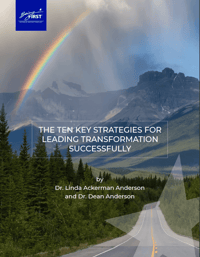Transformational change has so many unknowns and complexities that it is impossible to plan it accurately from the beginning.
A change audit assesses the current reality of your change initiative while it is underway. It can provide accurate information about whether or not your transformational change effort is set up to avoid rework and produce results quickly. It also sends a clear signal to the organization that you are serious about this change succeeding.
In this article, we explore different ways to design a change audit, how executives can best engage in the process and how it can be used to ensure your transformation is on track to reach your vision.
What Does a Change Audit Assess?
A Change Audit gives you a clear picture of your current reality so you can course-correct and strategically navigate to your desired outcomes.
An audit consists of three categories of assessment:
- Your change strategy for how the change is being led
- The organization's capacity to succeed in the change
- Leadership's capacity to lead the organization through the change successfully.
You may choose only one or two of the three areas, depending on the stage of your change, its urgency, and your priority concerns. Typically, a change audit occurs in the first stages of a transformation. After that, it can be repeated to produce a continuous source of insight for streamlining your change.
How Do You Design a Change Audit?
You can design an audit in various ways. From informal and personal, using only a few targeted one-on-one interviews and an informal report, to comprehensive and formal, using surveys, focus groups, and orchestrated feedback sessions. You can also involve your stakeholders, targets of the change, and all your change leaders and teams in the various initiatives underway.
A change audit can be designed with the help of expert guidance and then carried out yourself, or you can use external resources from "soup to nuts." Your timetable, risk level, and capability will help determine which approach you take.
What are the Benefits of Investing Time and Resources in a Change Audit?
Consider this: One of our clients had us perform a minimal assessment of their enterprise-wide transformation that was a year old and progressing with difficulty. They asked us to spend five days interviewing key players on the change and write a summary report about our findings and recommendations.
From this small investment, the executives discovered a mountain of urgent issues. They learned that their change had no transparent governance and was floundering among the top 400 leaders.
They discovered that the source of tremendous "angst" within the management ranks because of the lack of leadership, no clear roadmap, embarrassing political maneuvering, and no honest communication.
They uncovered a costly conflict between the running of the business and the execution of the change. This discovery made it clear to the leaders that the change strategy and timeline they had created did not match the reality of what they were trying to do. No wonder they couldn't get aligned action!
On the positive side, the leaders learned that the management and workforce were very excited about the possibilities for the new future. These stakeholders wanted to get on with the changes, increase their service offerings, and wait for clear direction. It was the perfect opportunity for the executives to step up to their change leadership responsibilities and course-correct their change strategy.
How Should Executive Leaders Engage in a Change Audit?
In the case of our example, the executives sponsored the change audit out of concern for the change's floundering and (fortunately!) used it as a conscious intervention to get everyone back on a path to success. The benefit to them, and in general, of doing a change audit, was getting accurate, objective information about what was happening, both good and bad. This data gave them clear guidance for realigning their efforts to get back on a positive course as quickly as possible.
Most importantly, these executives made the courageous choice to publicly "bite the bullet" of the "bad news" and thus reclaim their leadership of the organization and the change. They were able to model that they were ready and willing to do what was needed to make the transformation a success, in reality, not just in "lip service."
The leaders' actions saved them untold dollars, time, and unrest in the operations and their people, let alone the cost of failing at their change.
Want to Learn How to Use a Change Audit?
Watch the Webinar:
How to Use a Change Audit to Avoid the Cost of Rework During Transformation
Featured eBook:
The Ten Key Strategies for Leading Transformation

Through 40 years of observing and supporting large-scale change and transformation in Fortune 500, government, global NGOs and public service organizations, we’ve identified these ten Best Practice strategies for leading transformation successfully.
Please complete the form to download your eBook:
